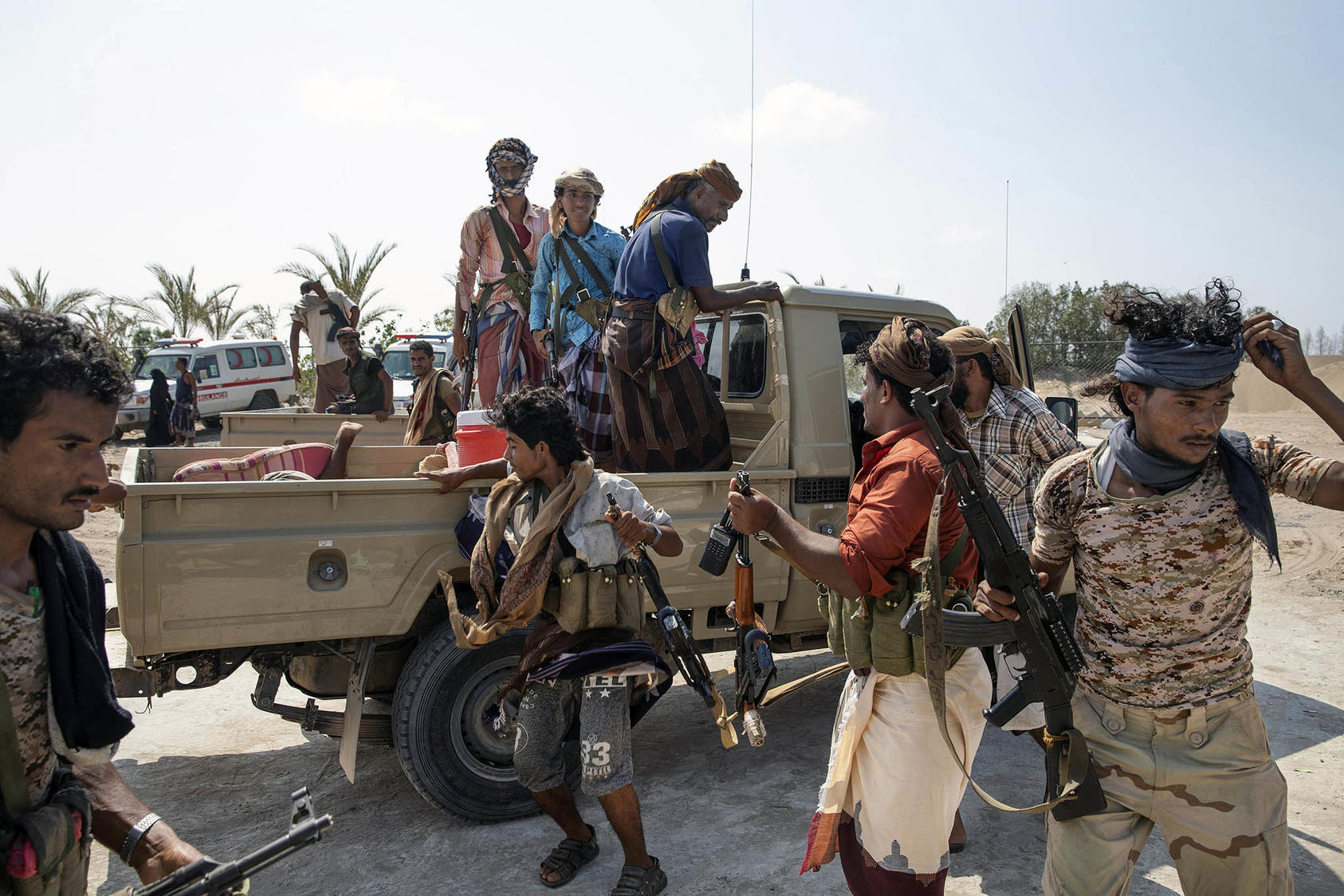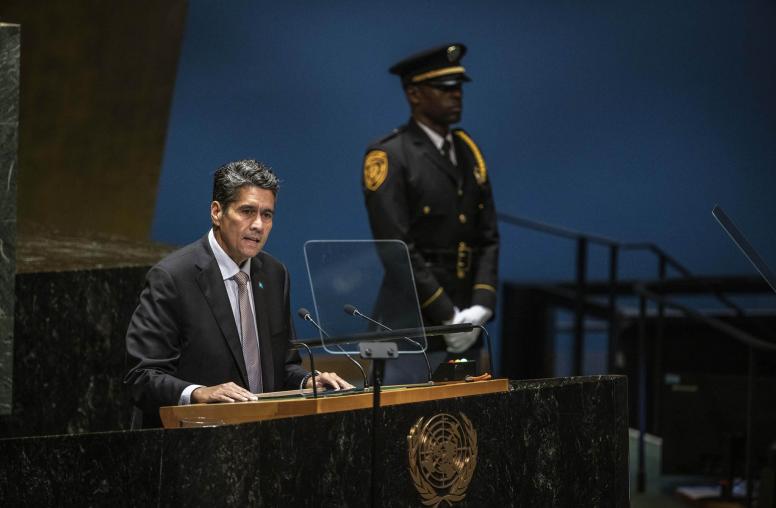What You Need to Know About China’s Saudi-Iran Deal
The agreement could have major implications for the Middle East. What does it mean for Beijing’s and Washington’s role in the region and beyond?
Iran and Saudi Arabia announced last Friday a Chinese-brokered deal to restore relations. After decades of enmity and a formal cutting of ties in 2016, the rapprochement has been touted as a momentous development in the region. But how it ultimately impacts the Middle East remains a very open question, as the long adversarial powers are fighting a proxy war in Yemen and continue to support opposing sides across the region. Amid perceived U.S. retrenchment from the Middle East, the deal is a diplomatic win for China as it increasingly seeks to present an alternative vision to the U.S.-led global order.

USIP’s Garrett Nada, Sarhang Hamasaeed and Adam Gallagher unpack the Iran-Saudi Arabia deal, and what it means for both countries, China and the United States.
Iran: An Opening Amid Increasing Isolation
Nada: The agreement on restoring ties was a boon for Iran’s government, which faced a daunting array of challenges in early 2023. Iran was increasingly isolated over its human rights record, controversial nuclear program and support for Russia’s war in Ukraine. So, Tehran was able to claim the announcement as a diplomatic victory.
The deal appeared to signal Iran’s intention to deescalate tensions with Saudi Arabia across the Middle East. The two have been on opposite sides of conflicts, particularly in Yemen and Syria. In Yemen, Iran has armed and aided the Houthis, while the Saudi military launched an air war in 2015 to prevent a complete takeover by Houthi rebels. The Houthis subsequently launched attacks on Saudi airports and oil facilities. More than 150,000 people have been killed during the war, including nearly 15,000 civilians. A six-month cease-fire expired in October 2022 but has largely held up.
Iran’s mission to the United Nations suggested that the thaw with Saudi Arabia could lead to a more durable solution. Iran reportedly agreed to stop arming the Houthis, although that commitment was not included in the brief joint statement by Iran, Saudi Arabia and China. Iran may have also seen the deal as an opportunity to demonstrate to China that it can play a constructive role in the Middle East. The Islamic Republic has a long record of meddling in the region, so committing to ratcheting down tensions with its regional rival was a significant move. For years, China has been a top oil importer for both Iran and Saudi Arabia. It sought stability in the Persian Gulf for the safe passage of oil and goods.
President Ebrahim Raisi’s February 2023 visit to China appeared to have paved the way for the trilateral announcement. During talks with Chinese leader Xi Jinping, “constructive ideas for the region were discussed & now they bear fruit,” Mohammad Jamshidi, Raisi’s deputy chief of staff for political affairs, tweeted on March 10. Amid rising tensions with Western powers, Raisi and Xi had pledged to strengthen security and economic cooperation. Raisi was the first Iranian leader to make a formal state visit to Beijing in more than 20 years.
The agreement also may yield some domestic reprieve. The Islamic Republic and the Gulf kingdom affirmed their respect for the “sovereignty of states” and “non-interference in internal affairs.” Saudi Arabia reportedly committed to pushing for less disparaging coverage of Iran by Iran International, a Persian-language satellite news channel, officials from both countries told The Wall Street Journal. For years, Tehran has accused Saudi Arabia of fomenting unrest through the channel. Iran International has maintained that it is independent, although Saudi businesspeople and individuals linked to the royal court have reportedly funded it.
The agreement was also a welcome economic boost, at least in the short term. By March 2023, the rial had lost about half of its value against the U.S. dollar since nationwide protests broke out in September 2022 after the death of Mahsa Amini in police detention. Within two days of the announcement on rapprochement, the rial surged 12 percent against the dollar. By March 12, one dollar was trading for 438,000 rials on the open market.
Saudi Arabia: Diversifying Alliances Amid a Changing Middle East
Hamasaeed: The Iran-Saudi agreement to restore diplomatic ties with the involvement of China is a sign of ongoing change in both countries, the broader Middle East and other global dynamics. The agreement provides important wins for each country, with Iran and Saudi Arabia clearly choosing to give China a considerable diplomatic victory. The two regional rivals have conducted talks in Oman and five rounds in Iraq in the past two years. They could have chosen either country to get to the finish-line, but instead chose China, shortly after the Xi's recent visit to Saudi Arabia, where he also met with other Gulf and Arab leaders.
Riyadh needed a new approach to deal with what seemed to be an unstoppable and expanding Iranian regional agenda, which included widening and deepening Iran’s direct and indirect influence in Iraq, Lebanon, Syria, Yemen and beyond. The Saudis and other Middle East countries feel U.S. security guarantees have not been sufficient, as critical Saudi and UAE infrastructure has been attacked while the United States has been seen as recalibrating its role in the region. Rather than buying expensive U.S. defensive weapons systems, the Saudis believe that China’s and Russia’s influence over Iran can help bolster their security.
Saudi Arabia needs to wind-down its military intervention in Yemen, stop attacks from Iran-backed Houthis, protect its border and investment climate, focus on a positive agenda — like its Vision 2030 — and engage Iran through dialogue and de-escalation instead of following the same old path of tension and conflict.
China’s involvement is yet another signal that Saudi Arabia is serious about diversifying and hedging even if it maintains its strategic alliance with the United States. China offers Saudi Arabia leverage with Iran, an alternative to the United States, deepening ties with Beijing, and technology and other resources that Riyadh needs.
In recent months, there has been whispers of a Saudi-Houthi deal being ready to sign imminently. But unlike previous times, it appears it’s the Saudis who have been holding off, perhaps waiting for the outcome of the direct talks with Iran.
The United States welcomed the agreement, while also casting doubt on Iran’s commitment to it. For the most part, regional countries — officials and citizens — welcome rapprochement between the two countries toward establishing regional security. Skepticism remains mostly about Iran, but also about the Saudis, too. The question on many minds is if both sides are just buying time or if this signals real change.
Will this agreement slow advancement on Iran’s regional agenda? Are the Saudis and others who oppose Iran’s actions aiming to slow down, stop or reverse Iran’s regional gains? The latter two do not seem to be within reach in the near to medium term. It also remains to be seen if Iran is just repositioning to lock in its regional gains or if relatively recent developments — like the killing of Quds Force Commander General Qassem Soleimani, the impact of economic sanctions, domestic unrest, Europe’s move toward the U.S. position on Iran, and Tehran’s support for Russia’s war in Ukraine pushing it closer to Beijing and Moscow — have engendered a real change in approach in Tehran.
Regardless of the intentions behind the deal, it is good to see dialogue resulting in agreement. Now the focus should be on outcomes and how this milestone could be built upon to continue to reduce tensions in the region and reach an acceptable regional security order.
China: Strategic Interests, Symbolic Victories
Gallagher: For China, brokering rapprochement between these two longtime Middle East rivals has key strategic and symbolic dimensions. On the strategic side, Beijing needs to maintain the free flow of oil from the region. But what the deal signals about Beijing’s role in global affairs may be just as, if not more, critical for China. Since Chinese leader Xi Jinping unveiled his Global Security Initiative (GSI) at the Boao Forum last April, and especially since Xi’s coronation for a third term in power this fall, China has been on a diplomatic offensive aimed at building an alternative to the United States’ dominance in global affairs.
Amid the tumult in global energy markets since Russia’s invasion of Ukraine, China needs stability in the Gulf, where it gets over 40 percent of its crude oil imports. Iran and Saudi Arabia represent the region’s two power poles, and have supported opposing sides in conflicts in Yemen, Lebanon, Iraq and Syria. Reducing their bilateral animosity could help lower tensions throughout the region.
In a widely watched visit to Saudi Arabia in December, Xi pledged to purchase more oil and gas from the Gulf, and also encouraged states in the region to conduct energy sales in the Chinese yuan. Some observers have speculated that the Iran-Saudi deal could set the stage for a broader employment of the petroyuan, whereby oil transactions would be settled in yuan, as opposed to the U.S. dollar, which for decades has been the standard currency used in energy transactions. China recently secured such an arrangement with Iraq and other countries have considered similar options amid U.S. sanctions on Russia.
As the rivalry between Washington and Beijing intensifies, the United States has restricted Chinese access to Western technology and markets. So, China needs to look elsewhere for stable flows of trade, technology and energy.
These are reasons enough for Beijing to celebrate this deal — but what it symbolizes about the U.S. role in the Middle East and China’s effort to supplant U.S. dominance in global governance may be even more important for China. With frosty U.S.-Saudi relations and Washington’s decades old adversarial relationship with Iran, the United States was not in a position to broker this agreement, despite being the preeminent external power in the region for 75 years. But still, as China made inroads in the Middle East in recent years, the United States remains the key defense and security actor in the region, even if its old allies, like Saudi Arabia, are increasingly looking to diversify their alliances. For its part, the Biden administration has said it is supportive of efforts to reduce tensions in the region.
This deal with Tehran and Riyadh comes on the heels of China’s so-called “peace plan” for the war in Ukraine — a proposal much ballyhooed in Beijing that more or less amounted to a recapitulation of anti-U.S. talking points — and the release of a “concept paper” elaborating on Xi’s GSI. In the principles espoused in both the peace plan and the GSI, China emphasizes the importance of sovereignty and noninterference in domestic affairs, which makes Beijing an appealing interlocutor for Riyadh and Tehran, two notorious human rights abusers.
The animating force behind these principles is to build an alternative to the U.S.-led global order, which China positions as a more multilateral approach to global security. Both the Saudis and Iranians have expressed interest in joining the BRICS (made up of Brazil, Russia, India, China and South Africa), and the Chinese have reportedly been supportive. Together, these countries — particularly with the addition of Saudi Arabia and Iran — could represent a powerful economic bloc and political force. Iran is set to become a member of the Shanghai Cooperation Organization — a Eurasian political, economic and security grouping headquartered in Beijing — and there is talk of Saudi Arabia joining.
As the United States has rallied Western allies in defense of Ukraine, China has looked to bill itself as the leader of an emerging, alternative multilateral order and a responsible great power. Beijing hopes that the international community will look at its role in the Iranian-Saudi deal as an example of China’s growing clout and ability to lead.



